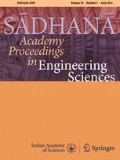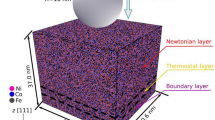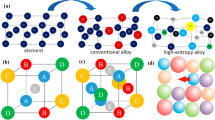Abstract
Self-heating effect for thermomechanical forming processes turns out to be dramatically significant for material with a very low melting point, such as zinc alloys. Zinc low melting point temperature (419.54°C) accentuates metallurgical effects when it is formed in cold or warm manufacturing processes. During deformation, self-heating can therefore induce a relative softening in the behavior law (that could improve formability) which competes with the conventional plastic hardening of the material. Hence, the correct identification of zinc material behavior has to account for both softening and hardening phenomena. This paper studies the effect of plastic work energy in the material identified by means of tensile tests by combining digital image correlation and infrared thermography technique.













Similar content being viewed by others
References
Taylor G I and Quinney H 1934 The latent energy remaining in a metal after cold working. In: Proceedings of the Royal Society of London. Series A 143, pp. 307–326
Milesi M, Logé R E and Jansen Y 2014 Anisotropic behavior and formability criterion for zinc sheets. J. Mat. Process. Tech. 214: 2869–2876
Feng F, Huang S, Meng Z, Hu J, Lei Y, Zhou M, Wu D and Yang Z 2014 Experimental study on tensile property of AZ31B magnesium alloy at different high strain rates and temperatures. Mater. and Design 57: 10–20
Jansen Y 2013 Modélisation et optimisation du processus de formage de pièces en zinc. PhD, MinesParistech, Sophia-Antipolis, France
Pantazopoulos G, Toulfatzis A, Vazdirvanidis A and Rikos A 2017 Fundamental aspects of rolled Zn alloy sheet formability: structure-property and failure mode relationships. Mat. Sci. Forum, Trans. Tech. Publications 879: 1443–1448
Porter FC 1991 Zinc Handbook: Properties, Processing, and Use in Design, Marcel Dekker, New York
Zehnder A T, Babinsky E, Palmer T 1998 Hybrid method for determining the fraction of plastic work converted to heat. Exp. Mech. 8 (4): 295–302
Zehnder A T 1991 A model for the heating due to plastic work. Mech. Res. Commun. 18(1): 23–28
Pottier T, Toussaint F, Louche H and Vacher P 2013 Inelastic heat fraction estimation from two successive mechanical and thermal analyses and full-field measurements. European J. Mech. A/Solids 38: 1–11
Macdougall D 2000 Determination of the plastic work converted to heat using radiometry. Exp. Mech. 40(3): 298–306
Ravichandran G, Rosakis A J, Hodowany J and Rosakis P 2002 On the conversion of plastic work into heat during high-strain rate deformation. In: Proceedings of AIP Conference 620, pp. 557–562
Ulacia I, Salisbury C P, Hurtado I and Worswick M J 2011 Tensile characterization and constitutive modeling of AZ31B magnesium alloy sheet over wide range of strain rates and temperatures. J. Mater. Process. Tech. 211(5): 830–839
Meyer L W, Herzig N, Halle T, Hahn F and Krueger L 2007 Staudhammer KP. A basic approach for strain rate dependent energy conversion including heat transfer effects: An experimental and numerical study. J. Mater. Process. Tech. 182: 319–326
Hor A, Morel F, Lebrun J L and Germain G 2013 Modelling identification and application of phenomenological constitutive laws over a large strain rate and temperature range. Mech. of Mat. 64: 91–110
Hor A 2011 Simulation physique des conditions thermomécaniques de forgeage et d’usinage : caractérisation et modélisation de la rhéologie et de l’endommagement. PhD, Arts et Métiers Paristech, Angers, France
Ghaffari Tari D and Worswick M J 2015 Elevated temperature constitutive behavior and simulation of warm forming of AZ31B. J. Mater. Process. Tech. 221: 40–55
Van Den Boogaard A H 2002 Thermally Enhanced Forming of Aluminium Sheet: Modelling and Experiments. PhD, Twente, The Netherlands
Chrysochoos A, Wattrisse B, Muracciole J M and El Kaïm Y 2009 Fields of stored energy associated with localized necking of steel. J. Mech. Mat. and Struct. 4(2): 245–262
Candau N, Pradille C, Bouvard J L and Billon N 2016 On the use of a four-cameras stereovision system to characterize large 3D deformation in elastomers. Polymer Testing 56: 314–320
Reibez P S 2008 Influence of thermal and mechanical aspects on deformation behavior of NiTi alloys., Grenoble: PhD, University of Joseph-Fourier, France
Lasdon L S, Fox R L and Ratner M W 1973 Nonlinear Optimization Using the Generalized Reduced Gradient Method. Technical Memorandum n° 325, NTIS
Roux E 2011 Assemblage mécanique: stratégies d’optimisation des procédés et d’identification des comportements mécaniques des matériaux. PhD, MinesParistech, Sophia-Antipolis, France
Author information
Authors and Affiliations
Corresponding author
Rights and permissions
About this article
Cite this article
MILESI, M., MUÑOZ, D.P., LAGROUM, A. et al. Self-heating of rolled ZnCuTi sheets. Sādhanā 45, 189 (2020). https://doi.org/10.1007/s12046-020-01426-x
Received:
Revised:
Accepted:
Published:
DOI: https://doi.org/10.1007/s12046-020-01426-x




